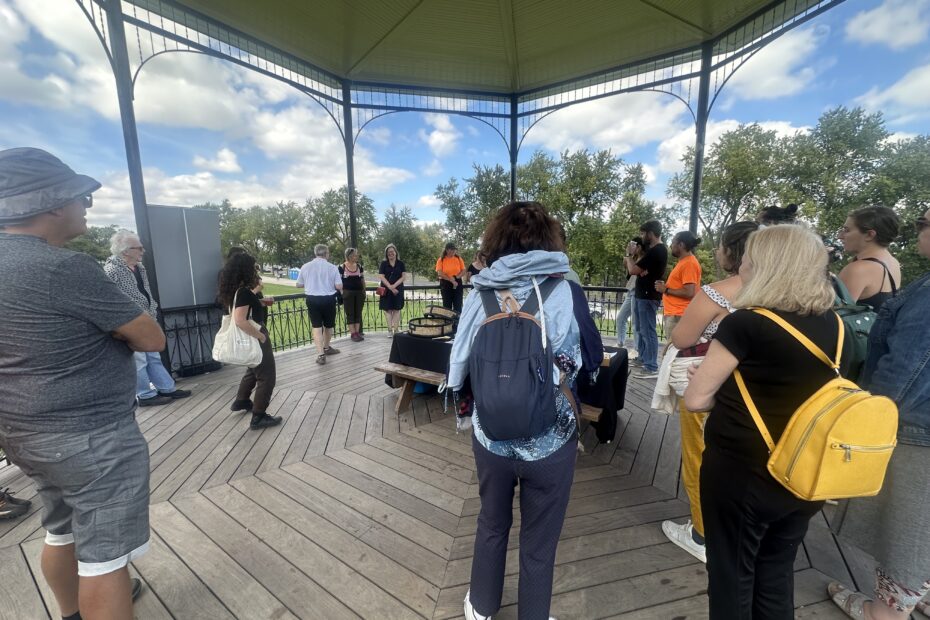Jamais Lu, in collaboration with Musique Nomade, has built a pathway into restoration with their latest project, Tiohtià:ke: Mapping Indigenous Stories. Under the artistic direction of Alexia Vinci, this initiative highlights the rich Indigenous heritage of Tiohtià:ke (Montreal) through the words of Indigenous authors, allowing us to connect not just to the stories but to the land itself as a living entity.
I had the privilege of attending the performance celebrating the launch on September 21, in which an actor and team of volunteers led us up Mont-Royal, immersing us in the stories that form the heart of this project. But it wasn’t just about hearing the words; it was about feeling them through every step we took, with the earth beneath us and the sky above, making the experience deeply meaningful.
As we gathered at the Mordecai-Richler Pavilion, we were met by volunteers wearing orange T-shirts – a reminder of the legacy of residential schools and a commitment to the promise that every child matters. The pavilion had been filled with bannock, jams, and homemade berry punch for attendees. There was an openness in the air – people were sharing stories of what brought them to the event, and why these kinds of gatherings are so important. As for me, I took a moment to acknowledge the power of community: of coming together not just to witness, but to meaningfully engage in something larger than ourselves.
During the launch, I had the chance to speak with the artistic director Alexia Vinci, and explore our shared Mi’kmaq identities. There’s something deeply grounding about those kinds of chance encounters – discovering similarities and differences between my being from Millbrook, and Alexia from Gespeg. We reflected on our variety of experiences, and how that diversity of perspective has enriched our collective understanding of what it means to be Indigenous on these lands. We found that these stories are present in all Indigenous peoples who call this place home.
I especially appreciated how the Tiohtià:ke: Mapping Indigenous Stories project honours both our land-based traditions and our oral histories, weaving the two together throughout various texts. These texts, written by six different Indigenous authors, offer perspectives on Tiohtià:ke/Montreal that challenge what we might know about these lands. Following earlier iterations in 2022 and 2023, the project has now expanded into a podcast series, co-produced with Musique Nomade. As of September 21 two podcasts, Sous les branches du pin blanc (Under the Branches of the White Pine) from Moira-Uashteskun Bacon and L’étoile du jour (The Star of the Day) from Jocelyn Sioui, are available online for all to experience. (But even so, there’s something special about hearing them while being on the very land they speak about that can’t quite be matched.)
Our journey up Mont-Royal was more than a walk; it reminded me of land-based ceremonies at home. As we moved between stops, we listened to the actor give voice to the stories from the second podcast – Jocelyn Sioui’s L’étoile du jour (The Star of the Day). Even when I couldn’t grasp every word due to the language barrier, the tone and raw emotion of the actor’s performance transcended language and I felt connected to something much deeper – something that spoke to the land, to our shared histories, and to the invisible threads that braid us all together.
While I had the privilege of being accompanied by a fellow, bilingual McGill student who helped translate parts of the text, it’s clear that these performances weren’t merely to be heard, but to be felt. You don’t need perfect linguistic comprehension to engage with them: sometimes, letting go of the need to understand every word opens you up to a fuller experience, as I felt it did in my case.
Another important aspect of the experience was connecting with other attendees who were not Indigenous. It was powerful to hear their reflections on how this project impacted them and about their respective roles in reconciliation. Relationships and connections are essential to our worldview, and this experience showed me just how much can be gained from these spaces – how storytelling and connection can foster new understandings and growth amidst fractured relations.
Although the live performances introducing this project are over, the podcasts are still available to be listened to at any time. I would encourage listening to them while walking through your own landscapes – whether up Mont-Royal like we did, or through any place that holds meaning for you. There’s power in engaging with these stories while moving physically across the land, allowing them to shape your experience in real time.
As an Indigenous anglophone in Quebec, I often feel like I’m navigating two worlds. There’s a duality to my experience here, and one that can feel isolating at times. But projects like Tiohtià:ke: Mapping Indigenous Stories remind me that there is strength in choosing to participate in these collective events anyway, even when I couldn’t fully understand the language of the performance. There is power in sitting with discomfort, in letting the land and the stories speak to us in ways that go beyond words.
Sovereignty, after all, is not just about asserting our rights over land – it’s about Indigenous people reclaiming our right to experience and engage fully with the world around us. By connecting with these podcasts, you wouldn’t just be listening to stories: you’ll be actively participating in an act of restoring sovereignty, an act of connection – an act of healing. So take a walk, listen to their stories, and see what they awaken in you: moment by moment, story by story.
To listen to both podcasts, visit www.nikamowin.com.
